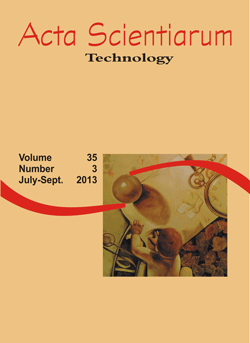<b>Antinociceptive activity and acute toxicological study of a novel sulfated polysaccharide from <em>Caulerpa cupressoides</em> var. <em>lycopodium </em>(Chlorophyta) in Swiss mice</b> - doi: 10.4025/actascitechnol.v35i3.15365
DOI:
https://doi.org/10.4025/actascitechnol.v35i3.15365Palavras-chave:
green alga, sulfated sugars, nociception, biochemical analysisResumo
Caulerpa cupressoides var. lycopodium (Chlorophyta) contains three sulfated polysaccharides (SPs) fractions (SP1, SP2 and SP3); but, their pharmacological properties have been limited. We investigated the antinociceptive activity of non-anticoagulant fraction (SP1) and then its acute toxicological study in male Swiss mice was performed. Animals (19-25 g) received i.v. SP1 30 min. prior to injection 0.8% acetic acid (10 mL kg-1, i.p.); 1% formalin (20 µL, i.pl.) or were subjected to thermal stimuli. Open-field test was also performed. Mice were treated i.p. with SP1 or 0.9% saline (0.1 mL 10 g-1) for 72h. On the 4th day, the animals were anesthetized and sacrificed in order to collect blood and organs. SP1 (3, 9 or 27 mg kg-1) reduced (p < 0.05) the number of writhes induced by acetic acid by 44.21, 47.72 and 90.87%, respectively. SP1 inhibited (p < 0.05) the second phase of the formalin test, without antinociceptive effect in the hot-plate test, suggesting that its analgesic action occurs through of peripheral mechanisms. SP1 did not modify the locomotor activity. SP1 (27 mg kg-1) did not cause hepatic or renal dysfunctions, but affected the spleen of animals (p < 0.05). Therefore, SP1 has analgesic action with high tolerance by the animals, presenting its potential applicability in pain conditions.
Â
Â
Downloads
Downloads
Publicado
Como Citar
Edição
Seção
Licença
DECLARAÇíO DE ORIGINALIDADE E DIREITOS AUTORAIS
Declaro que o presente artigo é original, não tendo sido submetido í publicação em qualquer outro periódico nacional ou internacional, quer seja em parte ou em sua totalidade.
Os direitos autorais pertencem exclusivamente aos autores. Os direitos de licenciamento utilizados pelo periódico é a licença Creative Commons Attribution 4.0 (CC BY 4.0): são permitidos o compartilhamento (cópia e distribuição do material em qualqer meio ou formato) e adaptação (remix, transformação e criação de material a partir do conteúdo assim licenciado para quaisquer fins, inclusive comerciais.
Recomenda-se a leitura desse link para maiores informações sobre o tema: fornecimento de créditos e referências de forma correta, entre outros detalhes cruciais para uso adequado do material licenciado.



















